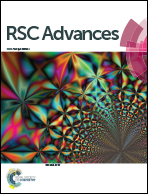Cacalol and cacalol acetate as photoproducers of singlet oxygen and as free radical scavengers, evaluated by EPR spectroscopy and TBARS†
Abstract
Photodynamic therapy (PDT) is an emerging cancer treatment based on the production of singlet oxygen (1O2) upon illumination of a photosensitizer in the presence of oxygen. Antioxidants are primarily reducing agents prone to scavenge reactive species in one way or another. Cacalol (C) and cacalol acetate (CA) were examined and compared regarding to their capacity to produce singlet oxygen and as scavengers of free radicals. Their role as singlet oxygen photoproducers under UV-vis light irradiation was examined by electron paramagnetic resonance (EPR) using 2,2,6,6-tetramethyl-piperidine (TEMP) as spin-trapping material. The quantum yield to produce 1O2 was found to be 0.4 ± 0.05 for CA and 0.13 ± 0.05 for C. Their properties as scavengers of hydroxyl (˙OH), nitrogen-centered (2,2-diphenyl-1-picryhydrazyl radical, DPPH˙) and organic radicals (R˙ and ROO˙) were evaluated using EPR and the thiobarbituric reactive substances (TBARS) method. C and CA differed in their abilities to trap DPPH˙. By contrast, both compounds showed similar activity to trap ˙OH, R˙ and ROO˙. A relationship between the redox potentials of the compounds and their activity as scavengers of DPPH˙ was observed. The producing/inhibiting properties showed by C and CA make them interesting options for new therapeutic applications to treat tumors and other diseases.


 Please wait while we load your content...
Please wait while we load your content...